The Western Digital WD Blue SN500 SSD Review: Moving The Mainstream To NVMe
by Billy Tallis on April 19, 2019 9:30 AM ESTAnandTech Storage Bench - The Destroyer
The Destroyer is an extremely long test replicating the access patterns of very IO-intensive desktop usage. A detailed breakdown can be found in this article. Like real-world usage, the drives do get the occasional break that allows for some background garbage collection and flushing caches, but those idle times are limited to 25ms so that it doesn't take all week to run the test. These AnandTech Storage Bench (ATSB) tests do not involve running the actual applications that generated the workloads, so the scores are relatively insensitive to changes in CPU performance and RAM from our new testbed, but the jump to a newer version of Windows and the newer storage drivers can have an impact.
We quantify performance on this test by reporting the drive's average data throughput, the average latency of the I/O operations, and the total energy used by the drive over the course of the test.
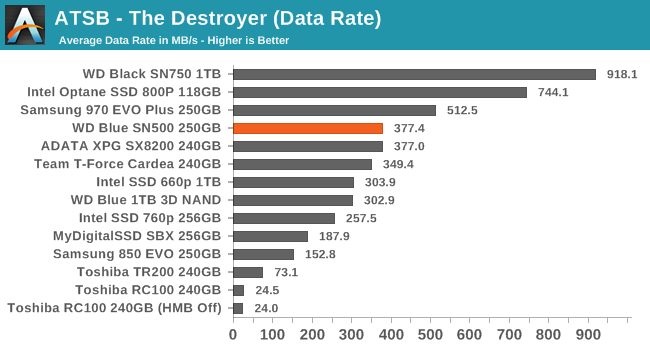
The average data rate of the WD Blue SN500 on The Destroyer puts it in a tie with the ADATA SX8200 and ahead of other entry-level NVMe drives. The 250GB SN500 outperforms even the 1TB SATA WD Blue SSD and the 1TB QLC-based Intel 660p. Samsung's 970 EVO Plus is significantly faster overall, but that's to be expected considering there is no more high-end option in this capacity class.
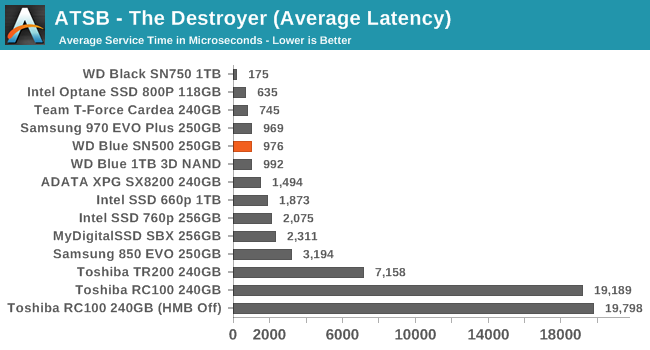
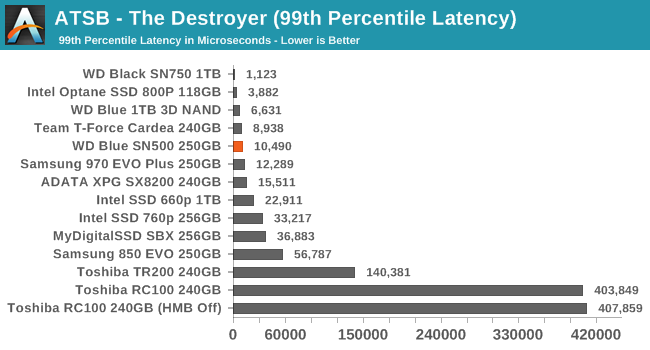
The great average and 99th percentile latency scores from the WD Blue SN500 on The Destroyer make it easy to forget that the SN500 is designed to be an entry-level NVMe drive, not a flagship high-end product (to the extent that such a thing is possible with TLC NAND in such small quantities).
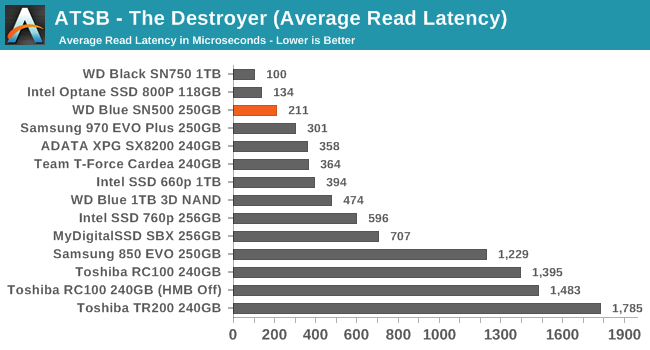
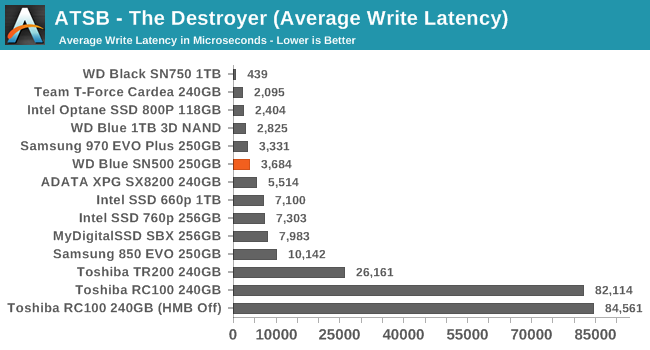
The average read latency of the WD Blue SN500 on The Destroyer is faster than any other drive in its capacity class, and only 60% slower than the Intel Optane 800p. The average write latency doesn't stand out much from the competition, but the SN500 is still behaving more like a high-end drive rather than showing any of the acute weaknesses often found in entry-level products.
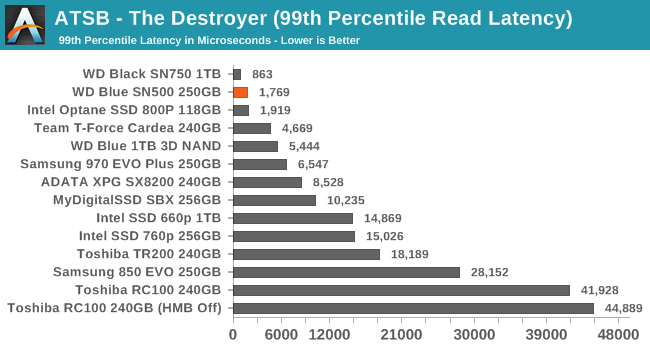
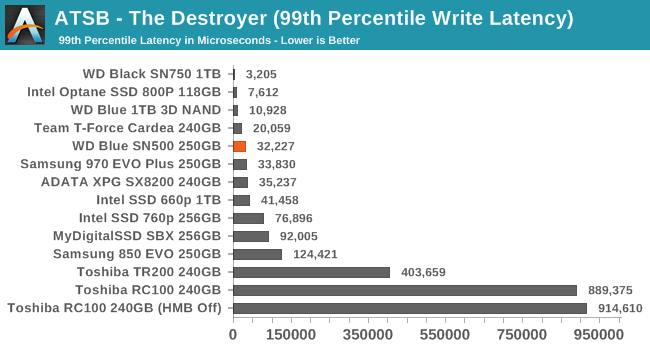
The 99th percentile read and write latency scores from the SN500 are similarly excellent, and better than can reasonably be expected from a DRAMless SSD that we know is doing a lot of background garbage collection during this test.
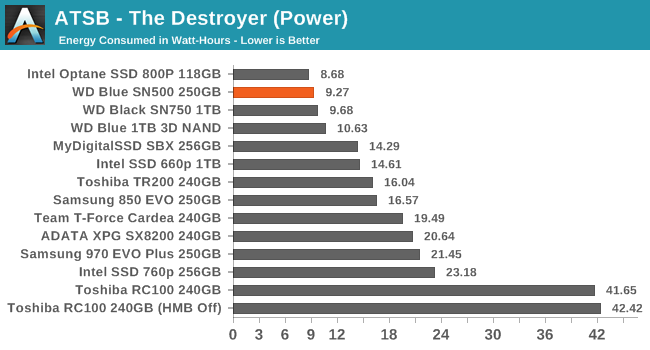
The WD Blue SN500 was quite power efficient during The Destroyer; despite being significantly slower overall than the WD Black SN750, the SN500 used a bit less energy in total. The other drives in its capacity class all used at least 50% more energy to complete this test, and the Toshiba RC100 despite seeming most similar at a high level (DRAMless, TLC, NVMe) took several times longer to run the test and used several times the energy.










50 Comments
View All Comments
Marlin1975 - Friday, April 19, 2019 - link
Actually not bad for one that does not have any large external buffer. That and this is the 250gb model so the 500 should perform a little better as well.Dragonstongue - Friday, April 19, 2019 - link
970 Evo Plus quite stands out for NVME based drives at ~$35 more for same size (just did a price check, amazon, 500gb for this vs 970 evo plus)so while "on paper" this appears great price, is still in very tough ground with ample contendors such as crucial with their p3 ( I believe it was called) countless samsung entries and the like.
for an extra ~$30-$40 seems like "normally" is just not worth it when can do for ones self (such as clock up the slower product, tweaking voltages and the like) when it comes to a "paper" difference and more or less proven real world data this is not all that good a price.
IMO is we take even a high performance HDD as a regular car speed, sata ssd (even highest performance) still is like an expensive supercar speed difference, the next jump would be the nvme based ones which are like top fuel dragsters (at best) but few tracks let them breathe proper and have to deal with engine problems (throttling etc) that normal drive do not have to deal with AND more $$$$$$..
top fuel costs $$$$, do you ALWAYS see this speed, nope, but when you do, is wonderful, when you do not, it becomes a "so why did I pay that much more for little gain and loss in capacity as well as specific motherboards to tap the advantage" etc etc.
kudos to WD, but alas, the margins are so very narrow and expected performance so high is near a non starter for all companies.
I feel the "new standard" for storage should be @500gb for performance and capacity reasons with 1tb prefered (even a 250nvme + whatever size SSD flash in a raid internal no driver required fashion .. I always liked concept of hybrid drives, why not use hybrid memory styles to leverage as well, instead of saddling fast memory with spinning rust, use high speed low endurance flash with lower speed high endurance other flash.
they do pci-e basd, nvme based, sata based etc etc, all have own benefit and detriment. I personally love sata based, leave the motherboard real estate for other things, they should do a further rendition of sata for the hole outs (like me and others whom have a variety of reasons)
if they can patch pci-e to nvme, why not use sta 6 (like current) but tap x2 or x4 pci-e lanes to it as well, let us call it SATA-X, backwarrds compatible with Sta 6g to sata 1 ofc, this would allow some sata or whatever drives up their speed but use a familiar/durable/more widespread form factor.
if all nvme based drives would work in all board or they would not interfere with mobo, not have throttle issues because of dog meta cooling designs (motherboard AND drive maker often enough) it would not be as much an issue, I like sata drive for such reasons, mainly can look "nicer" tend to be much more durable, that much less costly etc etc.
anyways, if WD could do 500 for the price of the 250, that would be most excellent, but as the pricing is, mehhh, overall nice rounded performance with no real shortcomings compared to many others even some of the much more $ drives are not as "rounded" for this they at least did very well at, that much should be said.
like Crucial with MX100, MX500, Samsung with the 800 through 970s (sata and nvme ofc) there are levels that are nice to hit, this SN500 is very much on that edge, up the performance a tough more, reduce price a touch (keep say $40 or better gap between this and the 970 evo plus) then this is that new "leg"
crucial 100/mx500 are more "budget" compared to the "sometimes" faster sammy 8xx/9xx drives, sammy ofc got the speed and endurance markers out there, this "could be" that leg of "rounded performance" just like the mx500 or sammy 8xx/9xx evo ^.^
sonny73n - Saturday, April 20, 2019 - link
Is this a comment or an essay?Hul8 - Saturday, April 20, 2019 - link
"Stream of consciousness" is a style, but usually only applied to fiction.LMonty - Sunday, April 21, 2019 - link
Haha! He just needed to get it out of his system :)Thud2 - Saturday, April 20, 2019 - link
Can you elaborate?Jorgp2 - Sunday, April 21, 2019 - link
Pretty sure this is targeted mostly at OEMsDyneCorp - Wednesday, April 24, 2019 - link
The MX500 is on par with the 860 EVO. SSDs with Micron 64-layer 3D TLC NAND and the SM2262 controller (HP EX920 and ADATA SX8200) absolutely destroy Samsung 9 series NVMe SSDs in certain metrics.The initial price of any product is always high. The SN500 will drop in price. In fact, its not even selling at its suggested retail price from most retailers.
And by the way, comparing SSDs to motor vehicles is ridiculous. Please stop.
jabber - Friday, April 19, 2019 - link
It will do fine for a Steam drive.fazalmajid - Friday, April 19, 2019 - link
I don’t see how such puny capacities can be mainstream, specially when most motherboards or laptops have a limited number of M.2 slots. My minimum would be a 1TB or 2TB Intel 660P.